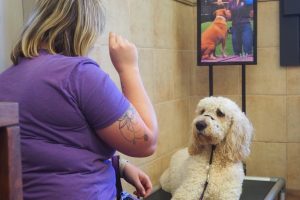
Do you recall the feeling you had when your parent would give you your allowance for doing your chores? It made you want to continue completing your chores, right? That’s called Positive Reinforcement.
Similarly, dogs are motivated to perform behaviors for treats, food, and praise. Positive Reinforcement trains your dog to associate a reward with a desired behavior. This is the training method we utilize in both our Lodge & Learn as well as Day Training programs. We condition our students to understand that for every positive behavior they perform, a reward will be given. Executing a reward system for your dog sounds simple enough, and it is. But it works effectively when you follow a few important steps.
Timing
Rewarding your dog within seconds of them performing a desired behavior is imperative. If you dog lies down but gets backup before you reward them for laying down, then you are rewarding the act of standing. Therefore, they will associate standing as the positive behavior. That’s why making sure you reward them right when they perform the command correctly is important.
Keep It Short
As much as we’d like to think that our pups can understand what we’re saying, the truth is they can’t. While they can’t understand full sentences, they do understand body language. Your dog actually learns from your body language first. That means that working on physically encouraging your dog to perform a command like “sit” or “stay” is the first step before trying to use a verbal command. Reward them when they perform the command nonverbally first.
Consistency
This is key! The moment your dog performs the desired action you asked them to perform, reward them. Don’t take “breaks” from training just because you’re out in public or at a friend’s house. Your pup doesn’t stop learning based on where you are. Keep treats on hand to be able to reward them. It’s easy to become lax on training when you are relaxing, but understand that your dog doesn’t understand that and you could be sending confusing signals.
But don’t worry, you won’t be bound to carrying around a pocket full of treats everywhere forever (unless you’d like to). By rewarding desired behavior consistently, you’ll find that your pup will want to complete your command just to please you and treats can be phased out.
If you’re interested in learning more about our training programs, be sure to ask one of our concierges for more information.

